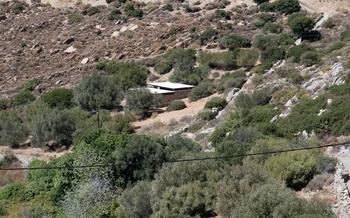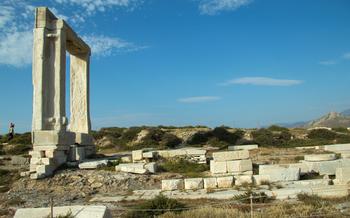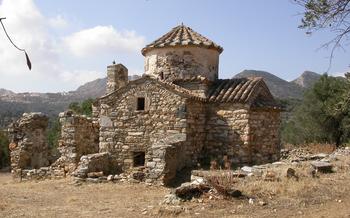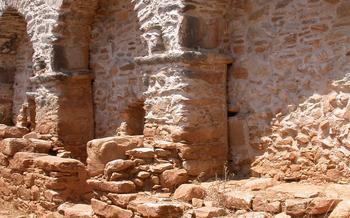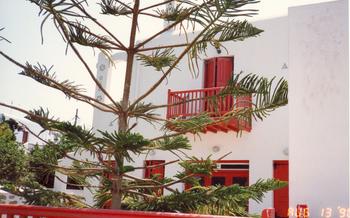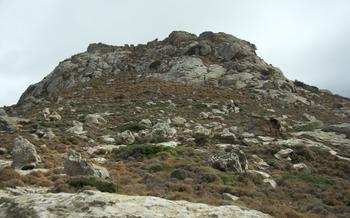
Sifones Aqueduct
- Historical Background
- Finding the Location
- Exploring the Aqueduct
- Nature's Canvas
- Educational Aspect
- Exploring the Aqueduct's Function
- Photographic Opportunities
- Greek Mythology and Legends
- Cultural Significance
- Preservation Efforts:
- Combining History with Leisure
- Local Crafts and Artisans
- Ecological Importance
- Architectural Details
- Insider Tip:
Historical Background
The Sifones Aqueduct, an awe-inspiring testament to ancient engineering prowess, stands as a silent witness to centuries of human ingenuity. Its significance lies not only in its architectural grandeur but also in its role as a lifeline for the ancient city of Naxos. Built in the 6th century BC, the aqueduct stands as a remarkable example of the advanced hydraulic engineering skills possessed by the ancient Greeks. Its innovative design and construction techniques ensured a steady supply of fresh water to the city, contributing to its prosperity and growth. The aqueduct's builders, whose names have been lost to time, left behind a legacy that continues to inspire and amaze generations, showcasing the enduring power of human innovation and engineering brilliance.
Finding the Location
The Sifones Aqueduct stands amidst the awe-inspiring landscapes of the Greek island of Naxos, a gem of the Aegean Sea. It resides in the picturesque village of Eggares, tucked away amidst rolling hills and lush greenery. To reach this historical marvel, visitors can embark on a scenic drive from Naxos Town, the island's vibrant capital. The journey takes approximately 25 minutes, offering breathtaking views along the way. Alternatively, one can opt for a leisurely bike ride, immersing themselves in the tranquility of the countryside. Once in Eggares, the aqueduct's imposing structure emerges as a testament to ancient engineering prowess. It stands as a beacon of history, inviting travelers to explore its secrets and marvel at its grandeur.
Exploring the Aqueduct
The Sifones Aqueduct is an awe-inspiring testament to the ingenuity of ancient engineers. Stretching for an impressive length of 3 km, this aqueduct showcases intricate structural details and captivating visual appeal. Its segmented construction, consisting of multiple arches, gracefully traverses the rugged terrain, providing a picturesque sight for visitors. Notable features along the aqueduct's path include carefully engineered channels that regulated water flow and provided a constant supply to the city. The aqueduct's strategic location allowed it to capture and transport water from distant springs, ensuring a vital resource for the flourishing population of Naxos. Excavations conducted near the aqueduct have unearthed fragments of pottery and ancient tools, offering glimpses into the daily lives of those who constructed and maintained this remarkable feat of engineering.
Nature's Canvas
The Sifones Aqueduct is surrounded by breathtaking natural landscapes that offer a feast for the eyes. The aqueduct stands amidst rolling hills covered in lush greenery, olive groves, and vineyards. The air is filled with the sweet scent of wild thyme, lavender, and rosemary, creating an aromatic tapestry that enhances the overall experience. As you stroll along the aqueduct, you can spot various wildflowers, including vibrant poppies, delicate daisies, and colorful lupins. The area is also home to a diverse range of wildlife, including birds, butterflies, and small mammals. Birdwatchers can delight in observing the graceful flight of eagles, hawks, and owls. The aqueduct provides a vital habitat for these creatures, supporting a rich and diverse ecosystem. Nature enthusiasts will find ample opportunities to immerse themselves in the beauty of the surroundings, whether it's through photography, birdwatching, or simply taking a leisurely walk. The Sifones Aqueduct truly showcases the harmonious blend of human ingenuity and the wonders of nature.
Educational Aspect
The Sifones Aqueduct is a treasure trove of knowledge, offering a unique opportunity for visitors to delve into the past and learn about the ingenuity of ancient civilizations. Informative signboards and plaques provide detailed explanations about the aqueduct's construction, operation, and historical significance, ensuring visitors gain a comprehensive understanding of this engineering marvel.
Historical and cultural tours are conducted by local experts, bringing the aqueduct's story to life and shedding light on its role in shaping the region's history and culture. These tours offer an immersive experience, allowing visitors to explore the aqueduct in greater depth and gain insights into the lives of those who built and used it centuries ago.
The Sifones Aqueduct stands as a testament to the remarkable engineering achievements of the ancient Greeks. By studying its design and construction, visitors can appreciate the ingenuity and precision that went into its creation. The aqueduct serves as a reminder of the importance of water management in ancient times and demonstrates the remarkable ability of ancient civilizations to harness nature's resources for the benefit of their communities.
Exploring the Aqueduct's Function
The Sifones Aqueduct stands as a testament to the ingenuity of ancient engineers. Its primary purpose was to transport water from the mountainous region to the city of Naxos, addressing the critical need for water management in ancient times. This remarkable feat of engineering involved the construction of an elaborate system of channels and underground tunnels, ensuring a steady flow of water.
The aqueduct's design allowed water to be collected from natural springs and channeled through a series of underground pipes made from clay or stone. These pipes were carefully laid with a slight gradient, enabling water to flow by gravity. The system was meticulously engineered to minimize water loss and maintain a consistent flow rate.
Comparing the Sifones Aqueduct to other similar structures in Greece offers valuable insights into the development of water management techniques in the region. While aqueducts were not uncommon in ancient Greece, the Sifones Aqueduct stands out for its unique construction, utilizing underground tunnels instead of elevated structures. This innovative approach allowed the aqueduct to traverse challenging terrain and deliver water to the city even during periods of drought or enemy attacks.
Photographic Opportunities
The Sifones Aqueduct is a photographer's paradise, offering stunning panoramas and picturesque vistas. The best time to capture the aqueduct's beauty is during the golden hours of sunrise and sunset, when the warm light casts a magical glow on its ancient stones. For capturing the essence of the aqueduct, experiment with different angles and perspectives. Shoot from above to emphasize its scale and grandeur, or take close-ups to reveal the intricate details of its construction. Utilize the surrounding nature as a backdrop, incorporating the lush greenery or the azure waters of the Aegean Sea into your compositions. Take advantage of the aqueduct's height by positioning your camera at different levels to create dynamic and unique shots. Remember, the Sifones Aqueduct is not just a historical monument; it's a canvas waiting to be painted with the colors of your creativity.
Greek Mythology and Legends
The Sifones Aqueduct is entwined with Greek mythology and legends that have been passed down through generations, adding a mystical aura to its existence. According to local folklore, the aqueduct was built by the mythical figure of Hercules, who is revered for his superhuman strength and feats of bravery. Legend has it that Hercules was tasked by King Eurystheus to complete twelve labors, and one of these involved bringing water to the drought-stricken city of Tiryns. With his characteristic might, Hercules is said to have diverted a river's course using the Sifones Aqueduct, bringing life-giving water to the parched land and saving the city from despair. This tale serves as a testament to the aqueduct's enduring significance, not only as a marvel of engineering but also as a symbol of hope and resourcefulness.
Cultural Significance
The Sifones Aqueduct is deeply intertwined with the cultural tapestry of Naxos. It has served as a source of inspiration for local artists, writers, and historians. The aqueduct's enduring presence has shaped local traditions and folklore, becoming an integral part of the island's identity. Festivals and events are often held near the aqueduct, honoring its historical significance and celebrating the community's resilience. The aqueduct stands as a symbol of the ingenuity and determination of past generations, reminding the people of Naxos of their rich heritage and the importance of preserving their cultural treasures.
Preservation Efforts:
The Sifones Aqueduct, a testament to ancient engineering prowess, has withstood the test of time but is not immune to the ravages of nature and neglect. Recognizing its immense cultural and historical significance, local authorities and organizations have undertaken meticulous restoration and maintenance projects to preserve this invaluable heritage for generations to come. These initiatives involve careful cleaning, repairs to structural elements, and reinforcement using traditional techniques to maintain the integrity of the original design. The local community plays a crucial role in these endeavors, actively participating in preservation efforts and raising awareness about the importance of safeguarding such remarkable landmarks. By supporting restoration projects and promoting responsible tourism, visitors can contribute to the preservation of this awe-inspiring monument, ensuring its legacy endures for centuries to come.
Combining History with Leisure
Exploring the Sifones Aqueduct doesn't have to be just about history and architecture. You can easily blend cultural immersion with leisurely pleasures to create a memorable experience. Start with a visit to the aqueduct during the late afternoon, when the golden hues of sunset illuminate the ancient structure. As you soak in the beauty, take a moment to immerse yourself in the tranquil atmosphere.
After your historical exploration, indulge in a culinary journey at one of the charming cafes or tavernas in the vicinity. Savor the flavors of traditional Greek cuisine while enjoying the panoramic views of the aqueduct and the surrounding landscape.
To extend your historical and culinary adventure, consider pairing your visit to the Sifones Aqueduct with other nearby attractions. The island of Naxos offers a wealth of cultural and natural treasures, including ancient temples, picturesque villages, and pristine beaches. Tailor your itinerary to suit your interests, whether it's exploring archaeological sites, indulging in local delicacies, or basking in the Mediterranean sun.
Local Crafts and Artisans
Amidst the allure of ancient ruins, Naxos offers a vibrant tapestry of traditional crafts and artisans. The island's rich cultural heritage is evident in its handcrafted souvenirs and local products, each imbued with stories and techniques passed down through generations.
From intricate pottery and ceramics to delicate woven goods and handmade jewelry, the island's artisans pour their passion and skill into creating unique pieces that embody the spirit of Naxos. Explore the local markets or visit artisan workshops to discover an array of hand-crafted treasures.
Immerse yourself in the creative process as you witness artisans meticulously shaping clay, weaving colorful threads, or forging intricate metalwork. Their dedication to preserving their craft is a testament to the island's deep-rooted traditions.
Support local artisans by purchasing their unique creations, knowing that each piece carries a piece of Naxos' history and culture. Whether it's a hand-painted ceramic plate, a finely woven basket, or a piece of handcrafted jewelry, your purchase contributes to the preservation of these traditional crafts and helps sustain the livelihoods of local artisans.
Engage with the artisans, learn about their techniques, and gain insights into the stories behind their creations. These interactions offer a profound connection to the island's cultural heritage and provide a deeper appreciation for the skill and artistry that goes into each handcrafted piece.
As you explore Naxos, embrace the opportunity to support local crafts and artisans. Their creations are not just souvenirs; they are tangible expressions of the island's rich cultural heritage, a testament to the enduring spirit of creativity that thrives within this vibrant community.
Ecological Importance
The Sifones Aqueduct stands as a testament to the harmonious coexistence of ancient engineering marvels with the natural world. The surrounding landscape, a tapestry of verdant hills and valleys, teems with diverse flora and fauna. The aqueduct's towering arches and sturdy construction have inadvertently created niches and habitats for a variety of wildlife. Birds, including majestic birds of prey, soar above the aqueduct, their calls echoing through the air. Small mammals scamper among the rocks and crevices, finding shelter and sustenance within the aqueduct's intricate structure. The aqueduct also serves as a vital corridor for reptiles and insects, contributing to the delicate balance of the local ecosystem.
Beyond its direct ecological impact, the Sifones Aqueduct also holds significance in promoting sustainable tourism. The preservation and appreciation of this ancient wonder encourage visitors to adopt responsible travel practices, minimizing their environmental footprint. The local community, recognizing the importance of protecting their natural heritage, has embraced ecotourism initiatives, offering guided tours that highlight the aqueduct's ecological significance. These efforts not only raise awareness but also provide economic incentives for the community to maintain and protect the aqueduct and its surroundings.
Architectural Details
The Sifones Aqueduct showcases remarkable architectural prowess. Constructed using local stone and mortar, it exhibits sturdy and precise masonry. The aqueduct's arches, some still intact, demonstrate the builders' mastery of structural engineering. Observe the finely cut stones that form the arches, each fitting seamlessly without the use of mortar, a testament to the skill of ancient Greek craftsmen. The aqueduct's walls also reveal interesting features, such as niches and recesses, which may have served as inspection points or provided structural stability. These intricate details add to the visual appeal of the aqueduct, making it a true masterpiece of ancient architecture.
Insider Tip:
For an unforgettable experience, visit the Sifones Aqueduct during the early morning hours, just as the sun is beginning to cast its golden glow over the surrounding landscape. The soft light illuminates the ancient stones, creating a magical ambiance that transports you back in time. As the sun rises higher, the views become even more breathtaking, with the aqueduct standing tall against the backdrop of the sparkling Aegean Sea.
And if you're a foodie, be sure to try the local specialty, the Naxian potatoes. These delicious potatoes, grown in the fertile soil of Naxos, are renowned for their unique flavor and texture. They are often served with grilled meats or fresh seafood, making for a truly memorable culinary experience.
